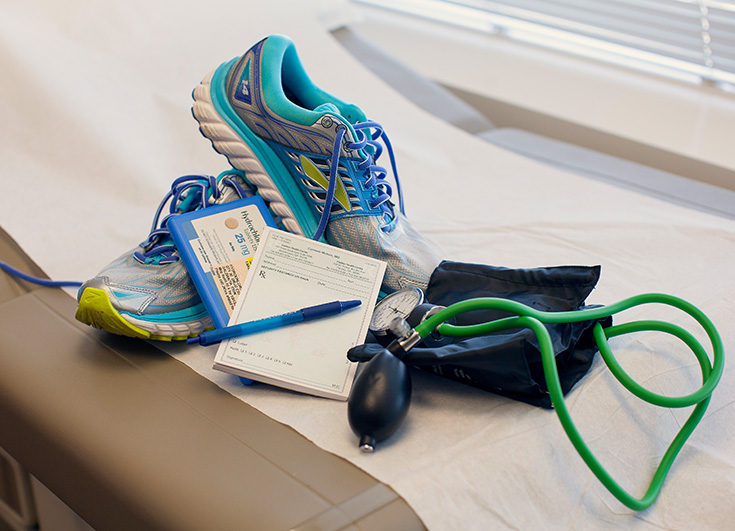
Now that you picked out the Rx Run-Walk and Rx Eat that are right for you, let’s look at a few very common health goals and see how your HER Prescriptions help you with these. We reviewed published scientific studies and called upon national experts to be sure what we present in this section reflects evidence and best medical practice. At the end of each health goal, we suggest a couple of extra resources that we use ourselves.
Many women have more than one specific health goal and will find that their HER Prescriptions are helping them address multiple ongoing health needs. For example, we know that there are millions of women with high blood pressure, high cholesterol, and diabetes or pre-diabetes. As we age, we all have aches and pains in bones, muscles, and joints, and we all benefit by finding better ways to cope with everyday life stressors.

HER Prescriptions are as important for our health as anything we can do. Don’t just take our word for it, try it, record your numbers, and prove it to yourself.

Have you been told you have high blood pressure, hypertension, or elevated blood pressure? If so, this section is especially for you.
Millions of women have high blood pressure and we know it is associated with heart disease, kidney problems, and strokes. There are good medications to help control blood pressure. In addition to taking medications, Rx Run-Walk can improve your blood pressure.
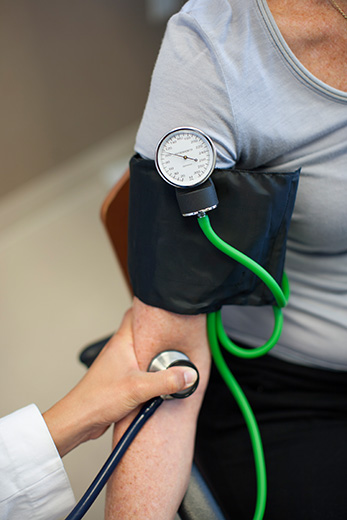
 Taking your Rx Run-Walk in the prescribed way is just as important as taking the other medications you have been prescribed for blood pressure control.
Taking your Rx Run-Walk in the prescribed way is just as important as taking the other medications you have been prescribed for blood pressure control.
 Reaching your full dose Rx Run-Walk will help reduce the risk for stroke by 27%.
Reaching your full dose Rx Run-Walk will help reduce the risk for stroke by 27%.
 Losing just 10% of your starting weight with Rx Eat will lead to a 5mm Hg decrease in your systolic blood pressure (that’s the first number in the blood pressure). For every 5% to 10% of additional weight lost, you’ll see another meaningful decrease in your blood pressure.
Losing just 10% of your starting weight with Rx Eat will lead to a 5mm Hg decrease in your systolic blood pressure (that’s the first number in the blood pressure). For every 5% to 10% of additional weight lost, you’ll see another meaningful decrease in your blood pressure.
 Some women will find that taking their Rx Run-Walk at full dose reduces the number of medications they need. Do NOT stop taking your blood pressure medications without talking to your doctor first.
Some women will find that taking their Rx Run-Walk at full dose reduces the number of medications they need. Do NOT stop taking your blood pressure medications without talking to your doctor first.
 Take your blood pressure medications except your diuretic (water pill that makes you pee) at night. Studies show that taking your blood pressure medications at night better controls your blood pressure when compared to taking medications in the morning.
Take your blood pressure medications except your diuretic (water pill that makes you pee) at night. Studies show that taking your blood pressure medications at night better controls your blood pressure when compared to taking medications in the morning.
 Follow your Rx Run-Walk and Rx Eat just like you follow dosing instructions for other blood pressure medications. Just like other medications, you should follow the instructions provided for your Rx Run-Walk and Rx Eat, and build up to your full dose carefully and gradually.
Follow your Rx Run-Walk and Rx Eat just like you follow dosing instructions for other blood pressure medications. Just like other medications, you should follow the instructions provided for your Rx Run-Walk and Rx Eat, and build up to your full dose carefully and gradually.
 REMEMBER: Absolutely NO huffing and puffing when you do your Rx Run-Walk.
REMEMBER: Absolutely NO huffing and puffing when you do your Rx Run-Walk.
 Take charge! Check your blood pressure every week and record it in your journal.
Take charge! Check your blood pressure every week and record it in your journal.
 Before you inflate the cuff, rest for 2 minutes in a seated position with your back supported and your feet flat on the floor. Now, check your blood pressure and record the numbers in your journal. Share your weekly log with your primary care provider.
Before you inflate the cuff, rest for 2 minutes in a seated position with your back supported and your feet flat on the floor. Now, check your blood pressure and record the numbers in your journal. Share your weekly log with your primary care provider.
 Take notes and check up on yourself.
Take notes and check up on yourself.
 Record your blood pressure (BP) in your journal.
Record your blood pressure (BP) in your journal.
 Record how you feel in your journal. Work to make this a habit and learn how your body adapts as you become a regular user of your Rx Run-Walk and Rx Eat.
Record how you feel in your journal. Work to make this a habit and learn how your body adapts as you become a regular user of your Rx Run-Walk and Rx Eat.
The Doc Box: You Can Still Go Injury-Free
You might have been prescribed one of the following common types of medications: beta-blocker, calcium channel blocker, or diuretic (water pill that makes you pee). These medications impact how you take your Rx Run-Walk. You must warm up gently. In the heat or when you are sweating, be particularly careful—slow down and drink enough water and other fluids. Remember, no huffing and puffing!
1.Toss the canned foods and the salt shaker. Canned beans are usually coated in a lot of salt. If you must eat canned beans, rinse the beans with water before using them.
2.Stay hydrated! Drink 6 to 8 big glasses of water every day.
American Heart Association Website, “Understanding Blood Pressure Readings”
Exercise Is Medicine, “Exercising with High Blood Pressure”
Patient Education: High Blood Pressure in Adults (Beyond the Basics) Up-to-Date Patient Sheets
Have you been told you have heart disease, including any of the following?
•Heart failure (CHF)
•Abnormal heart rhythm
•Atrial fibrillation
•Peripheral vascular disease
•Venous insufficiency
•Circulation problems
•Coronary artery disease (CAD)
•Heart disease
•Heart attack
•Myocardial infarction
If so, this section is especially important for you.
Heart disease is the number one killer of women and it causes 1 in 3 deaths every year. That’s scary. Some women feel even more afraid when thinking about starting to exercise when they have been told they have a heart condition. Most women do not understand how vital—meaning absolutely essential—exercise and diet are for heart health. Gentle exercise (i.e., a careful and gradual program) is even more important when you have a heart or circulation problem. The good news is that following a Rx Run-Walk can make your heart stronger and help you live longer and feel better.
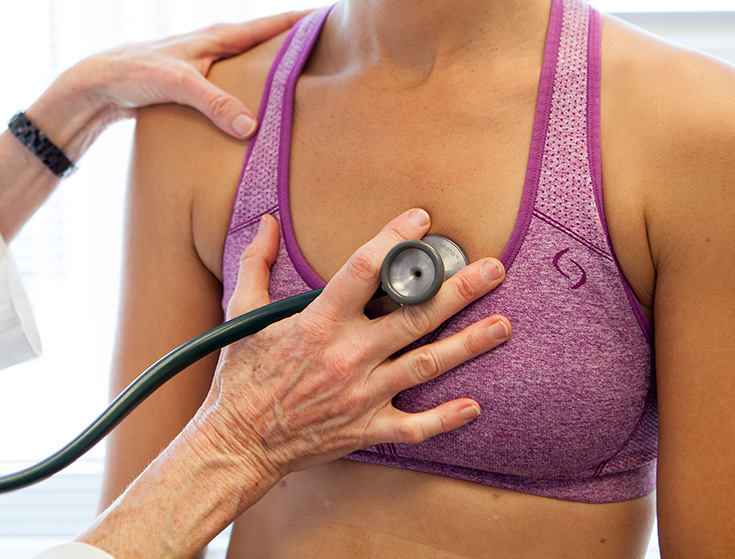
 This program has been used successfully for other people like you with heart problems.
This program has been used successfully for other people like you with heart problems.
 Losing weight reduces the strain on your heart.
Losing weight reduces the strain on your heart.
 Rx Run-Walk prevents and treats heart disease. Following your Rx Run-Walk and Rx Eat is just as important as taking your medications. Doing both is essential to improving your heart function.
Rx Run-Walk prevents and treats heart disease. Following your Rx Run-Walk and Rx Eat is just as important as taking your medications. Doing both is essential to improving your heart function.
 Taking your Rx Run-Walk at full dose will lower your risk of death from heart disease by at least 20%.
Taking your Rx Run-Walk at full dose will lower your risk of death from heart disease by at least 20%.
•Walk, walk, walk! Take as many breaks as you need. Intensity is your enemy. As you get started with your Rx Run-Walk, your goal is slow and steady not fast and far. No huffing and puffing.
•Use your journal to record how you feel and share it with your doctor.
•Make a plan with your doctor about what to do if you get warning symptoms like chest pain or shortness of breath.
•Record how you feel in your journal. Work to make this a habit and learn how your body adapts as you become a regular user of your Rx Run-Walk and Rx Eat.
•For you, it is especially important that you understand and know about your heart and symptoms you have that relate to how your heart is working. Some get short of breath because of their heart health. Some have chest tightness or feel their heart skipping beats or racing. Some may feel completely exhausted, their legs heavy or even painful. If you have been told you have heart disease like heart failure, rhythm problems, coronary artery disease, or circulation problems, or you’ve had a heart attack, talk to your doctor to be sure you understand how your body signals you about how your heart is functioning. Make a plan with your doctor for what you should look for and what to do.
•At each visit with your doctor, take your journal and your questions!
The Doc Box: You Can Still Go Injury-Free
Start where you are. The training programs are 30 weeks long because it takes this long for your body to adjust and become stronger. In chapter 3, you determined which of the three Rx Run-Walk training programs is right for you. Stay patient and determined. Don’t jump ahead. There are no short cuts.
Make sure to eat omega-3s. Omega-3s are a heart-healthy kind of fat. The healthiest way to eat omega-3s is by eating fatty fish like salmon, mackerel, or tuna twice a week. If you don’t eat fish, you can get some omega-3s from sources like walnuts, flaxseed, and soybeans. Just be aware that the health benefits aren’t as good as eating fish. You can also ask your doctor what dose of fish oil might be good for you as a supplement.
American Heart Association Exercise and Physical Activity in the Prevention and Treatment of Atherosclerotic Cardiovascular Disease, www.circulationaha.org
Have you been told you have one of the following?
•High cholesterol
•Hypercholesterolemia
•High lipids in your blood
•Dyslipidemia
•Hypertriglyceridemia
•Fat in the blood
If so, then this section is especially important for you.
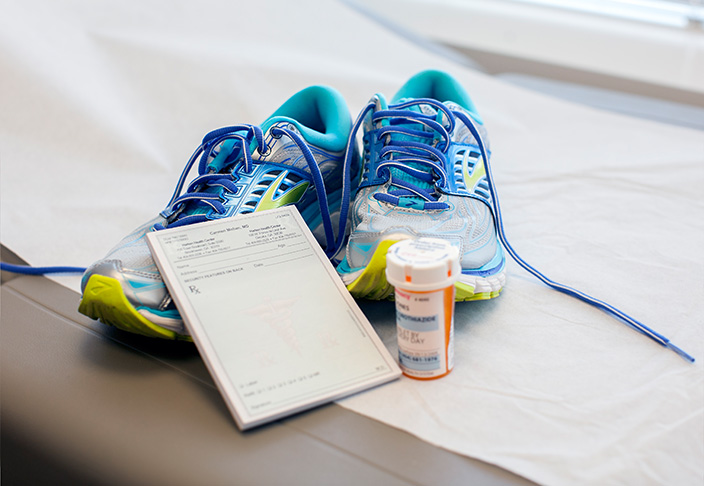
Cholesterol is a fat-like substance in your blood and can build up in the walls of blood vessels. This can lead to heart disease and stroke. You can do a simple blood test to check and follow your cholesterol. Your cholesterol is one of the important health numbers you should know and follow over time because it is associated with heart disease, stroke, and diabetes.
•The treatment of high cholesterol is a lifelong process.
•Your Rx Run-Walk and Rx Eat will improve your cholesterol even if you do not lose weight. But, if you are able to lose weight, your cholesterol levels will improve even more.
•Think of your Rx Run-Walk and Rx Eat as vital medications for treating your cholesterol.
•After you have been taking your Rx Run-Walk and Rx Eat for at least three months, ask your doctor to recheck your cholesterol. Some women will find that taking their Rx Run-Walk at full dose reduces the number of medications they need. Do NOT stop taking your cholesterol medication(s) without talking to your doctor first.
Review your food score in your journal every week. Make sure you are eating fish two times every week. Watch out for deductions. Keep that deduction number below two per week; zero is better!
The Doc Box: You Can Still Go Injury-Free
You may have been given a medication called a statin to help treat your high cholesterol. A small percentage of women who take statins get aches in their muscles when they exercise. If this happens to you, then you might need an even more gradual exercise program. Talk to your doctor if you are worried this might be happening to you. Remember, your prescribed medications work even better when you combine them with your Rx Run-Walk and Rx Eat.
Fish oil—Oily fish, such as mackerel, herring, bluefish, sardines, salmon, and anchovies, contain two important fatty acids, called DHA and EPA. Eating a diet that includes one to two servings of oily fish per week can reduce triglyceride levels (another type of fat in your blood) and reduce the risk of death from heart disease. Fish oil supplements are believed to have the same benefit. Your doctor might recommend that you take a daily fish oil supplement if you are not eating enough fish.
Soy protein—Soy protein contains isoflavones, and these mimic the action of estrogen. A diet high in soy protein can slightly lower levels of total cholesterol, LDL cholesterol, and triglycerides, and raise levels of HDL cholesterol. However, we do not recommend that you replace normal protein sources with soy protein or isoflavone supplements to try to lower your cholesterol level.
Soy foods and food products (e.g., tofu, soy butter, edamame, some soy burgers, etc.) are likely to have beneficial effects on lipids and heart health because they are low in saturated fats and high in unsaturated fats. You will see these listed on your Rx Eat, and can follow guidelines there on eating them.
Know the Facts About High Cholesterol. National Center for Chronic Disease Prevention and Health Promotion. Division for Heart Disease and Stroke Prevention. http://www.cdc.gov/cholesterol/docs/ConsumerEd_Cholesterol.pdf
Have you been told you have one of the following?
•Bad seasonal allergies
•Asthma
•Chronic obstructive lung disease (COPD)
•Chronic bronchitis
•A problem breathing caused by smoking tobacco
If you have been told you have one of these, then this section is especially for you.
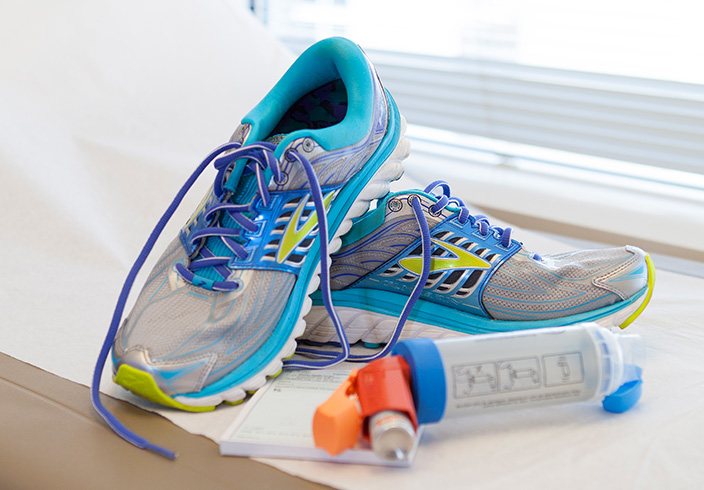
Trouble breathing is commonly caused by asthma, COPD, bad seasonal allergies, or chronic bronchitis. Many women with trouble breathing avoid exercising and because of this, breathing becomes even harder and shortness of breath occurs at even lower levels of activity. When you gradually become more active, you can reverse this and improve your ability to breathe.
 Be aware that stress, anxiety, or a low mood direct your attention to your breathing and make you feel even more breathless.
Be aware that stress, anxiety, or a low mood direct your attention to your breathing and make you feel even more breathless.
 Achieving your Rx Run-Walk and Rx Eat goals will require patience, determination, and being tuned in to your body’s growing ability to adapt and slowly improve over time.
Achieving your Rx Run-Walk and Rx Eat goals will require patience, determination, and being tuned in to your body’s growing ability to adapt and slowly improve over time.
 This program has been used successfully for other people like you with breathing problems.
This program has been used successfully for other people like you with breathing problems.
 Rx Run-Walk clears sputum from your lungs.
Rx Run-Walk clears sputum from your lungs.
 Weight loss makes it easier to breathe.
Weight loss makes it easier to breathe.
 As you progress with your Rx Run-Walk training program, you will be less short of breath with the same amount of walking.
As you progress with your Rx Run-Walk training program, you will be less short of breath with the same amount of walking.
 Women who exercise regularly are able to decrease their need for hospital admissions due to breathing problems.
Women who exercise regularly are able to decrease their need for hospital admissions due to breathing problems.
•Walk, walk, walk! Take as many breaks as you need. Intensity is your enemy. As you get started with your Rx Run-Walk training program, your goal is slow and steady, not fast and far. No huffing and puffing at any time!
•Use your journal to record how you feel and share it with your doctor.
•If it is extremely hot or cold outside, or if there is poor air quality, then you should exercise inside by walking on a treadmill.
•Make a plan with your doctor about what to do when you have a flare of your asthma, COPD, or chronic bronchitis. Know how to prevent and manage flare-ups when they happen. If you have been given an inhaler to use, be sure you know how to use it correctly and that you carry it with you.
For you, it is especially important that you understand and know about how your breathing problems relate to how your lungs are working. Some women with breathing problems feel very anxious, can’t stop coughing, or have difficulty catching their breath. If you have been told you have bad seasonal allergies, asthma, chronic obstructive pulmonary disease (COPD), or chronic bronchitis, be sure you talk to your doctor and understand how your body signals you about how your lungs are functioning.
The Doc Box: You Can Still Go Injury-Free
•If you have been prescribed inhalers or other breathing treatments, make sure to take them as prescribed. Using your inhalers with a spacer device can result in a 20% to 30% increase in the amount of medication delivered to your lungs. If you are not sure how to use your inhalers or a spacer, talk to a health professional like a pharmacist or doctor for help.
•If you have exercise-induced asthma, talk to your doctor about taking a kind of medication called a leukotriene inhibitor which can reduce the symptoms of bronchospasm.
•Bring your rescue inhaler with you when you walk.
Connect to a support group or program to help you quit.
Exercising With Chronic Obstructive Pulmonary Disease (COPD), Exercise is Medicine. www.exerciseismedicine.org
Exercising With Asthma, Exercise is Medicine. www.exerciseismedicine.org.
Have you been told you have pre-diabetes or diabetes? If so, then this section is especially for you.
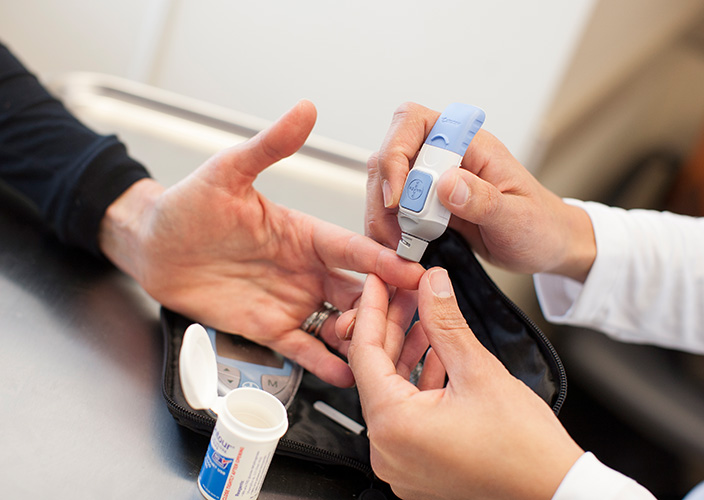
Rx Run-Walk has a key role to play in both preventing and treating blood sugar problems. In fact, Rx Run-Walk can help prevent diabetes-related problems with your nerves and kidneys. These benefits of Rx Run-Walk start the moment you walk out of the door and continue to grow as you work up to the fully prescribed dose of 150 minutes total per week. For example, on the day you run-walk, your blood sugars will be better.
You can make your blood sugar normal by losing 10% of your body weight using Rx Eat and full dose Rx Run-Walk: Keep Going. In other words, weight loss AND following Rx Run-Walk: Keep Going can markedly improve your diabetes.
 What and how you eat is especially important because it directly affects your blood sugar control. You have an important role in your own medical care, and monitoring your blood sugar is an opportunity for you to take control of your health.
What and how you eat is especially important because it directly affects your blood sugar control. You have an important role in your own medical care, and monitoring your blood sugar is an opportunity for you to take control of your health.
 Record everything you eat and drink honestly and accurately in your journal.
Record everything you eat and drink honestly and accurately in your journal.
 Check your blood sugar in the morning before breakfast and record it in your journal. If it is below 80, eat breakfast before you run-walk. If you feel like your blood sugar might be dropping during your run-walk, eat a piece of fruit or a couple of hard candies. You will become the expert on how your body responds to increasing your exercise.
Check your blood sugar in the morning before breakfast and record it in your journal. If it is below 80, eat breakfast before you run-walk. If you feel like your blood sugar might be dropping during your run-walk, eat a piece of fruit or a couple of hard candies. You will become the expert on how your body responds to increasing your exercise.
 If your doctor asks you to check your blood sugar two hours after your biggest meal each day, there is space for you to record blood sugar numbers in your journal.
If your doctor asks you to check your blood sugar two hours after your biggest meal each day, there is space for you to record blood sugar numbers in your journal.
 Review your journal entries with your doctor. Ask if any changes to your diabetes medications (including insulin if you use it) are needed.
Review your journal entries with your doctor. Ask if any changes to your diabetes medications (including insulin if you use it) are needed.
 Partner with a diabetes educator or a dietician to create weekly meal plans.
Partner with a diabetes educator or a dietician to create weekly meal plans.
 Think of your Rx Run-Walk and Rx Eat as vital treatment for diabetes.
Think of your Rx Run-Walk and Rx Eat as vital treatment for diabetes.
 Show your doctor your Rx Run-Walk training program. Ask the following questions:
Show your doctor your Rx Run-Walk training program. Ask the following questions:
 When should I take my prescription medicine(s)?
When should I take my prescription medicine(s)?
 Should I eat before physical activity or after?
Should I eat before physical activity or after?
 What should I do if I have low blood sugar during physical activity?
What should I do if I have low blood sugar during physical activity?
 Make a plan with your doctor about what to do if you get symptoms of low blood sugar like feeling shaky or light-headed.
Make a plan with your doctor about what to do if you get symptoms of low blood sugar like feeling shaky or light-headed.
 After you have been taking your Rx Run-Walk and Rx Eat for at least three months, ask your doctor to recheck your hemoglobin A1c. Some women will find that taking their Rx Run-Walk at full dose reduces the number of medications they need. Do NOT stop taking your medication(s) without talking to your doctor first about this.
After you have been taking your Rx Run-Walk and Rx Eat for at least three months, ask your doctor to recheck your hemoglobin A1c. Some women will find that taking their Rx Run-Walk at full dose reduces the number of medications they need. Do NOT stop taking your medication(s) without talking to your doctor first about this.
National Institute of Diabetes and Digestive and Kidney Diseases, Diabetes and Physical Activity. https://www.niddk.nih.gov/healthinformation/diabetes/diabetes-physical-activity
Exercising With Type 2 Diabetes, Exercise is Medicine. http://exerciseismedicine.org/assets/page_documents/EIM%20Rx%20series_Exercising%20with%20Type%202%20Diabetes_2.pdf
American Diabetes Association, Print on-demand materials. http://professional.diabetes.org/search/site?f%5B0%5D=im_field_dbp_ct%3A32&retain-filters=1
Have you been told you have vitamin D deficiency, osteoarthritis, osteoporosis, or had a joint replacement? If you have, then this section is especially for you.
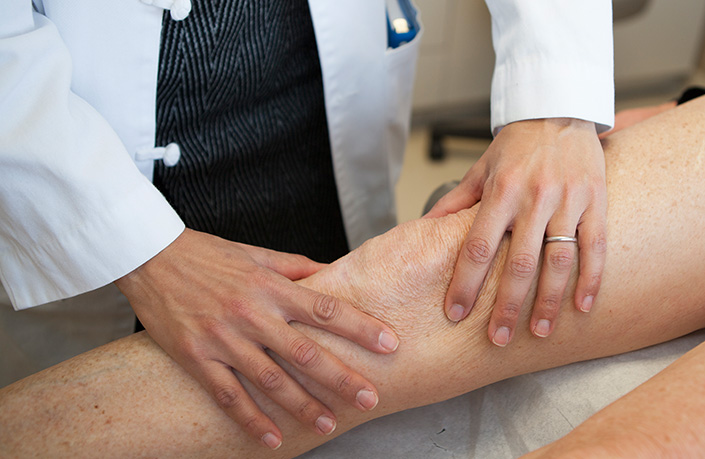
Osteoarthritis, which results from wear and tear on the joint, is the most common cause of joint pain. If we live long enough, we will probably all have osteoarthritis. About one-fourth of all people over age 55 have pain in their knees on most days and most of these people have osteoarthritis. Although not the same for everyone, osteoarthritis tends to be more severe as we age. Many women with joint aches or pains avoid exercising and because of this, moving becomes even harder and at even lower levels of activity. Gradually becoming more active can reverse this, improve your mobility, and actually help to decrease your pain and stiffness. Bones and muscles rely on each other and both require regular use, especially when joints ache and hurt.
Being overweight and female are risk factors for osteoarthritis of the knees and hips. Exercise with osteoarthritis can be hard and painful and often causes women to be less active. The lack of exercise makes joints stiffer and the surrounding muscles weaker. This leads to the vicious cycle of being even less active. Understand and believe that you can break this cycle. Though you may be taking medications for pain, the Rx Run-Walk will actually restore the health and integrity of painful joints and weak bones and muscles. Your Rx Run-Walk can decrease joint swelling and pain and improve the function of bones, muscles and joints. The key is to gradually start walking using the training program and stay determined to get the benefits.
When you lose weight, you lighten the work of your knees and hips. Weight loss enhances the benefits of regular Rx Run-Walk.
•Get started and stay determined. The training program will gently increase your activity level.
•Talk to a fitness coach or physical therapist about weight training. You can often find a professional who can design a weight-training program for you at your gym or YMCA. Personal coaching for weight training is often included with your gym membership.
•Combine your Rx Run-Walk with your Rx Eat to lose 0.5 to 1 pound weekly and keep going until your joints feel good. Target a normal body mass index of between 21 and 25, and plan to reach this goal with slow, steady determination and a plan.
•If you are especially bothered by a certain joint, consider writing down a pain score of 1 to 10 in your journal. Every 4 weeks, look back in your journal to see how the pain score changes. This can be very useful in keeping you motivated.
The Doc Box: You Can Still Go Injury-Free – Osteoporosis
•Osteoporosis, a loss of bone, is a serious concern for women especially as they age. Regular walking and a healthy diet improve the health of bones and muscles throughout life. Walking prevents bone loss because it encourages bone formation, stronger muscles, and better balance. These benefits reduce the chance of falling and breaking a bone.
•This program has been used successfully for other people like you with joint, muscle, and bone problems. This is because bones are designed to support our weight. Bones, especially those of women, require movement and holding weight to be strong. In fact, sitting is the worst thing we do for our bones.
•A regular habit of walking is important to decrease the bone loss that happens in everyone with aging. Walking in a way that significantly increases pain tends to be counterproductive. The use of a cane or hiking staff in the hand opposite the painful joint unloads the hip or knee significantly, and most people can significantly increase the distance of walking before pain becomes limiting by doing so. The cane can therefore be a very useful tool to increase comfortable walking for exercise.

If you have had a joint replacement, to get full benefit of the new joint, you will need to follow the Rx Run-Walk and Rx Eat to get to the full dose of walking and achieve a normal weight with a body mass index (BMI) of 21 to 25.
Over time, with repeated use and especially injury, the cushion in the joint space gets smaller. This cushion is called the articular cartilage and sits between the bones of the joint. Even when the bones in a joint contact each other (bone on bone) it is important to understand that your pain and ability to function will likely improve as you move toward your ideal body weight with Rx Eat. For most people, an ideal body weight is a BMI of 21 to 25. It is especially important that you start a weight training program (see below). If you have a joint that is red, swollen, and warm to the touch, you should be evaluated by your doctor. Often times, putting an ice pack on the joint twice a day will help soothe a flare of arthritis. In other words, the vast majority of women will feel better and their joints will be less stiff as they progress through the program. That doesn’t mean it will never hurt. It means that you must use pain as your guide.
You can still go, and will find that regularly following your Rx Run-Walk and charting your progress will prove that bothersome aches and pains can improve with regular exercise and weight loss. Our bodies are made to be and stay active!
No matter the problem with your bones or joints, it can improve with weight training. Especially for those in the Get Started program, the key is to find the exercise activities that provide the most exertion with the least amount of increased pain. A list of activities that work for many people with joint pain includes things like stationary biking or pool exercises. An excellent way for a woman with hip or knee pain to aerobically condition at a high level is with weights. Weight training in this setting should be with lighter weights and high repetitions without resting between sets. Use the machines that do not increase joint pain even if you are limited to working only the upper extremity. With this method it easy to push the heart rate into an aerobic zone without increasing joint pain.
•Vitamin D is essential for bone health. Run-walk outside so you get natural sunlight exposure as often as the weather permits.
•Ask your doctor if you need to take vitamin D supplements.
•Your Rx Eat will give you adequate calcium, but check with your doctor to see if you need more calcium.
Exercising with Osteoarthritis, Exercise is Medicine. http://exerciseismedicine.org/assets/page_documents/EIM%20Rx%20series_Exercising%20with%20Osteoarthritis.pdf
Exercise and Bone and Joint Conditions, American College of Orthopedic Surgery. http://orthoinfo.aaos.org/topic.cfm?topic=a00100
Do you have anxiety, seasonal affective disorder, depression, grief, or troubles with smoking, drugs, or alcohol use? If so, this section is especially for you.

When mental well-being is at risk, learning how to keep yourself motivated and active using Rx Run-Walk is one of the biggest gifts you can give yourself. Knowing the following facts will help you see you are not alone:
•Between the ages of 15 to 55, women are much more likely than men to find that their moods shift with the seasons. You may hear this referred to as seasonal affective disorder.
•While each woman’s experience is her own, mood swings are common throughout our lives. Menstrual cycles, pregnancy, the postpartum period, and menopause each have a distinct influence on a woman’s mood.
•Women are twice as likely as men to have depression. Forty percent of women will have a depressive episode at some point in their life.
•Grief, loss, and worries about our children and families weigh us down.
Regular exercise is a vital prescription across all ages for women. It gets you outside in the sunlight and among people, and helps you learn to lead with your heart with a smile on your face and find the wind at your back.

•The main symptom of depression is fatigue or feeling tired, so getting started is usually the biggest hurdle. Once you regularly run-walk, you’re almost half as likely to develop depression.
•Evidence shows that run-walk programs improve anxiety and depression. Your mood, self-esteem, and stress level all get better with regular exercise.
 Get at least 7 hours of sleep every night. Sleep helps improve mood.
Get at least 7 hours of sleep every night. Sleep helps improve mood.
 Longer walk sessions are especially important for mental well-being. Getting into the habit and sticking to your routine is especially important.
Longer walk sessions are especially important for mental well-being. Getting into the habit and sticking to your routine is especially important.
 Studies show that connecting with others who run-walk is essential for getting started and staying committed to reach the full dose of your Rx Run-Walk. Finding a partner or walking group or taking your dog with you can often improve your chances of getting started and keeping going.
Studies show that connecting with others who run-walk is essential for getting started and staying committed to reach the full dose of your Rx Run-Walk. Finding a partner or walking group or taking your dog with you can often improve your chances of getting started and keeping going.
 Work up to and maintain longer run-walk sessions. Studies show that depression improves at the full dose reached in the Rx Run-Walk: Burn Fat. If you have depression, you should aim to progress through the training programs as you are able and eventually reach the full dose of miles in the Rx Run-Walk: Burn Fat.
Work up to and maintain longer run-walk sessions. Studies show that depression improves at the full dose reached in the Rx Run-Walk: Burn Fat. If you have depression, you should aim to progress through the training programs as you are able and eventually reach the full dose of miles in the Rx Run-Walk: Burn Fat.
 Long-term regular exercise lowers anxiety. To fully treat anxiety with the Run-Walk program, aim to complete the Rx Run-Walk: Burn Fat. Maintain it and set gradual fitness goals that extend beyond it. This takes time, determination, and imagination.
Long-term regular exercise lowers anxiety. To fully treat anxiety with the Run-Walk program, aim to complete the Rx Run-Walk: Burn Fat. Maintain it and set gradual fitness goals that extend beyond it. This takes time, determination, and imagination.
•Search the web using these keywords “walking for fitness meet-up” followed by your city.
•Check with your human resources department to see if your employer offers walking groups as part of their wellness program.
•Your health insurer or health clinic might also have a list of community resources.
•You can find a list of Galloway Running Groups for over 100 cities at http://www.jeffgalloway.com/training-groups/list-of-cities

Use your journal to understand yourself and your habits around Rx Run-Walk, Rx Eat, and the company you keep. Note where you have successes and how success relates to where you run-walk, what you eat, and who you were with, and become an expert at setting yourself up for success. This takes time, patience, and determination.
There is a reflection section in the journal in which you are asked to complete the sentence “I feel…” Make sure you fill out that section regularly and look back every now and then to see how you are doing.
Use of any amount of tobacco and overuse of alcohol continue to be common problems; both negatively influence your mood. Remember your Rx Eat addresses everything you eat and drink. Finding a way to stop all use of tobacco and limit alcohol is part of your Rx Eat. Your Rx Run-Walk and Rx Eat are vital components of your overall approach to treating addiction. If you stick to the amount of alcohol that is allowed in your Rx Eat, you will not be drinking alcohol at a dangerous level.
Exercising With Anxiety and Depression, Exercise is Medicine http://exerciseismedicine.org/assets/page_documents/EIM%20Rx%20series_Exercising%20with%20Anxiety%20and%20Depression_2.pdf
John J Ratey. Spark: The revolutionary new science of exercise and the brain. January 2013.
Robert Waldinger. What makes a good life? Lessons from the longest study on happiness. http://www.ted.com/talks/robert_waldinger_what_makes_a_good_life_lessons_from_the_longest_study_on_happiness/transcript?language=en